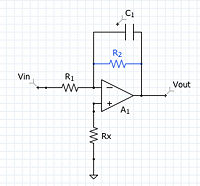Integrator Amplifier: Difference between revisions
(fixed sources likes and cited material) |
No edit summary |
||
| Line 12: | Line 12: | ||
The use of an integrator circuit is the opposite of a differentiator circuit. In other words, If you have a triangle wave input and you differentiate it you will get a square wave output. If you run the square wave as the input to an integrator circuit you will end up with the triangle wave for the output<ref><sup>Scherz, P: ''Practical Electronics for Inventors 2nd ed'', page 545. </sup></ref>. |
The use of an integrator circuit is the opposite of a differentiator circuit. In other words, If you have a triangle wave input and you differentiate it you will get a square wave output. If you run the square wave as the input to an integrator circuit you will end up with the triangle wave for the output<ref><sup>Scherz, P: ''Practical Electronics for Inventors 2nd ed'', page 545. </sup></ref>. |
||
The resistor (<math>R_{2}</math>) is used to provide feedback<ref><sup>[[Feedback_in_Amplifiers]]</sup></ref> of the output DC voltage. Without this, circuit wouldn't perform as calculated because of the un-ideal conditions of real life. |
The resistor (<math>R_{2}</math>) is used to provide feedback<ref><sup>[[Feedback_in_Amplifiers]]</sup></ref>. of the output DC voltage. Without this, circuit wouldn't perform as calculated because of the un-ideal conditions of real life. |
||
==Contributers== |
==Contributers== |
||
Revision as of 20:24, 17 January 2010
Amplifiers
Integrator
The circuit at right integrates the input voltage by using an amplifier.
" ; Provides negative feedback for low output impedance needs. But it also distorts the output."<ref>Quick Study "Electronics 1, Part 2"</ref>
The use of an integrator circuit is the opposite of a differentiator circuit. In other words, If you have a triangle wave input and you differentiate it you will get a square wave output. If you run the square wave as the input to an integrator circuit you will end up with the triangle wave for the output<ref>Scherz, P: Practical Electronics for Inventors 2nd ed, page 545. </ref>. The resistor () is used to provide feedback<ref>Feedback_in_Amplifiers</ref>. of the output DC voltage. Without this, circuit wouldn't perform as calculated because of the un-ideal conditions of real life.
Contributers
--Benjamin.henry 23:15, 10 January 2010 (UTC)
Reviewers
- http://en.wikipedia.org/wiki/This_article_does_not_cite_any_references_or_sources.#Footnote_system
- I don't think I would capitalize amplifier, differentiator , differentiate, integrator or resistor.
- I believe you mean triangle wave and square wave, in place of ^^^ and square sine wave.
- After you take these comments into consideration, email me again and I'll take a look at it once more.
Victor Shepherd
- I agree with Greg just like you did with square sine wave do the same with triangle wave instead of ^^^, makes it confusing and I don't believe that's a standard way of representing it.
- I will add one more thing. You don't need to have the types of waves within "".
Sources
<references/>



